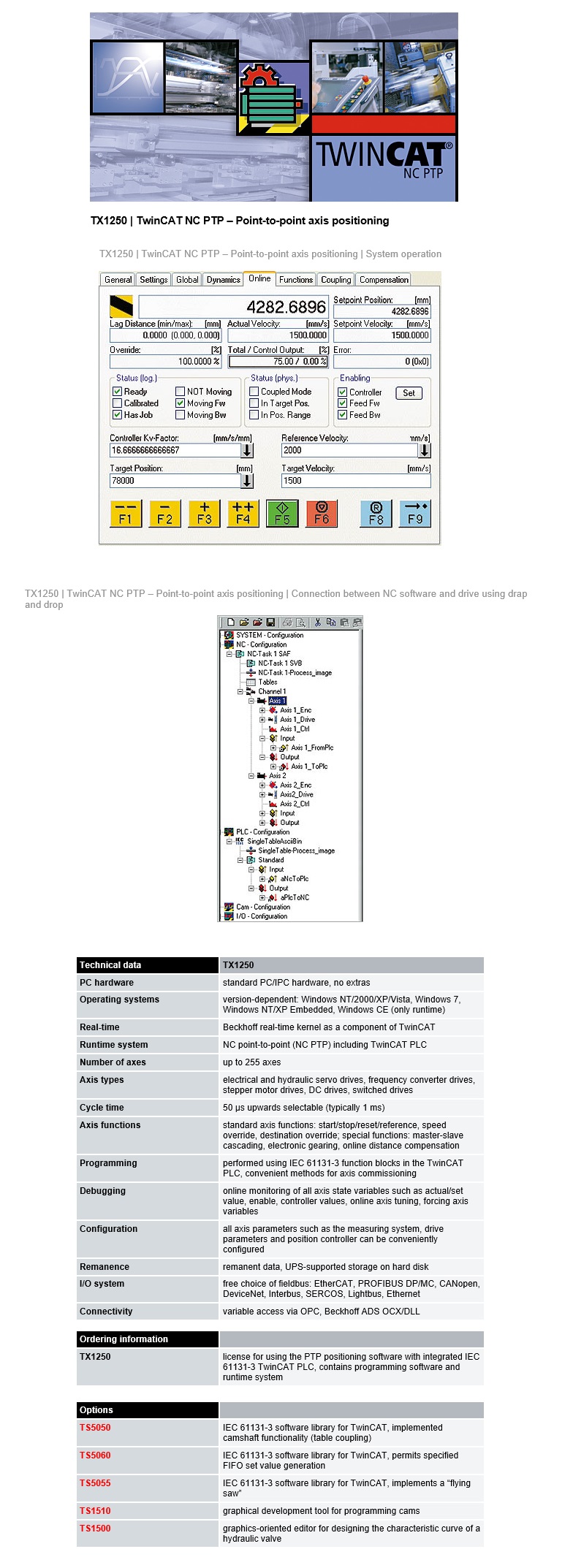 |
 |
 |
 |
Beckhoff: TwinCAT 2 (TX1250 Series)
The Windows Control and Automation Technology
The Beckhoff TwinCAT software system turns almost any compatible PC into a real-time controller with a multi-PLC system, NC axis control, programming environment and operating station. TwinCAT replaces conventional PLC and NC/CNC controllers as well as operating devices with: open, compatible PC hardware embedded IEC 61131-3 software PLC, software NC and software CNC in Windows NT/2000/XP/Vista, Windows 7, NT/ XP Embedded, CE programming and run-time systems optionally together on one PC or separated connection to all common fieldbuses PC interfaces support data communication with user interfaces and other programs by means of open Microsoft standards (OPC, OCX, DLL, etc.)
TwinCAT consists of run-time systems that execute control programs in real-time and the development environments for programming, diagnostics and configuration. Any Windows programs, for instance visualization programs or Office programs, can access TwinCAT data via Microsoft interfaces, or can execute commands. A practically oriented software solution TwinCAT offers a precise time base in which programs are executed with the highest deterministic features, independently of other processor tasks. The real-time load on a PC is set with TwinCAT; defined operating behavior is achieved in this way. TwinCAT indicates the system load for programs that are running. A load threshold can be set in order to assure a defined computing capacity for the operating programs as well as for Windows NT/2000/XP/Vista or Windows 7. If this threshold is exceeded, a system message is generated. TwinCAT supports system diagnosis The general use of hardware and software from the open PC world requires some checking: Unsuitable components can upset the PC system. Beckhoff has integrated a practical indicator of the real-time jitter, giving administrators an easy way to evaluate the hardware and software. A system message during operation can draw attention to incorrect states. Depending on the setting, TwinCAT is started and stopped manually or automatically. Since TwinCAT is integrated into Windows NT/2000/XP/Vista and Windows 7 as a service, an operator is not needed to start the system: switching on is enough. Restarting and data backup When a program is started or restarted, TwinCAT loads programs and remanent data. To backup data and to shut down Windows NT/2000/XP/Vista and Windows 7 correctly, a UPS (uninterruptible power supply) is of great value. TwinCAT and “Blue Screen” The TwinCAT system can be configured such that real-time capability is maintained in the event of a BSOD (Blue Screen of Death) operating system crash. Real-time tasks such as PLC and NC can therefore continue to run and bring the controlled process into a safe state. Ultimately, it is the decision of the programmer whether or not to utilize this feature, bearing in mind that data or programs may already have been destroyed by the BSOD. World-wide connection through message routing – “remote” connection is inherent to the system According to the requirement for operating resources, the TwinCAT software devices can be distributed: TwinCAT PLC programs can run on the PCs or on Beckhoff Bus Terminal Controllers. A “message router” manages and distributes all the messages, both in the system and via TCP/IP connections. PC systems can be connected with each other via TCP/IP; Bus Terminal Controllers are integrated via serial interfaces and fieldbuses (EtherCAT, Lightbus, PROFIBUS DP, CANopen, RS232, RS485, Ethernet TCP/IP). Since standard TCP/IP services of NT/2000/XP/Vista/CE and Windows 7 can be used, this data can be exchanged across the world. The system offers scalable communication capacity and timeout periods for the supervision of communications. OPC provides a standardized means for accessing many different SCADA/MES/ERP packets.
TX1250 | TwinCAT NC PTP – Point-to-point axis positioning
Position control with the PC TwinCAT NC PTP includes axis positioning software (set value generation, position control), an integrated software PLC with NC interface, operating program for commissioning and an I/O connection to the axes through various fieldbuses. TwinCAT NC PTP replaces conventional positioning modules and NC controllers. NC PTP software on the PC The controllers that are simulated by the PC cyclically exchange data with drives and measuring systems via the fieldbus. The capacity of a PC allows axes to be moved in parallel with the PLC functionality. PC power means that some tens of axes can easily be positioned simultaneously. Axes are structured into channels for PTP movement and for interpolated movements. TwinCAT NC PTP uses variables to operate axes. Each axis has variables for encoder, drive and controller. The axis can be linked to I/O interfaces, and parameters can be set. Position measurement systems The position controller acquires the actual position through: analog EtherCAT SERCOS SSI Lightbus PROFIBUS DP/MC pulse train
interfacing to all popular fieldbuses, e.g. EtherCAT, Lightbus, SERCOS, PROFIBUS DP/MC, synchron CAN Axis functions can be embedded into the IEC 61131-3 PLC system by means of function block libraries; the function blocks comply with the PLCopen standard. data interface to Windows NT/2000/XP/Vista/CE or Windows 7 programs by means of open standards (OPC, Beckhoff ADS)
Positioning is executed with a powerful, modern positioning algorithm in which profiles are generated with jerk limitation and with pre-control of speed and acceleration to minimize the following error. Controller structures can be adjusted. P controller PID controller PID with speed pre-control PID with speed and acceleration pre-control override functions
The online menu allows important axis parameters such as target position, set speed, acceleration, jerk, reference speed, controller Kv factor,
to be set, and general axis functions such as linear coupling (electrical gears) distance compensation online master/slave and slave/master conversion “flying saw” (diagonal saw) camming (support through TwinCAT Cam Design Tool) FIFO axes change over encoders/controllers external axis set value generator multi-master coupling

|
|
 |
 |
 |
 |

|